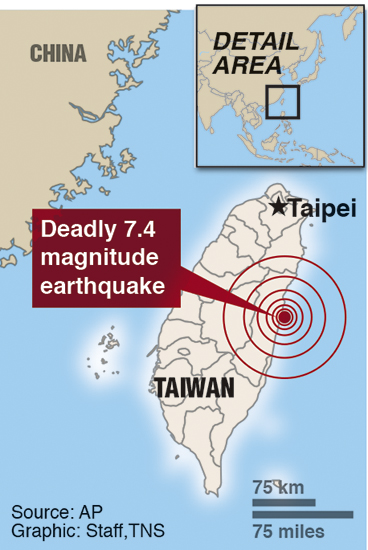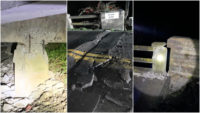Natural Disasters
Strong Taiwan Quake Destroys At Least 28 Buildings, But 1,667-Ft Taipei 101 Performs Well

Most building damage occurred in Hualien County, including at the mid-rise Uranus Building in Hualien City, where one person died.
Photo by VCG/Newscom
Full reports of damage were not immediately available after a magnitude-7.4 earthquake struck the east coast of Taiwan April 3, but its National Fire Agency reported 28 buildings collapsed, most in Hualien County—the area closest to the quake epicenter, killing at least nine people and injuring nearly 1,000. Most of the deaths resulted from landslides, which trapped 152 people in tunnels and in mountainous areas, the agency said.
It was the most severe quake felt in Taiwan in nearly 25 years.
In Hualien City, one person was killed in the partial collapse of the mid-rise Uranus Building, with some 10 occupied floors. Local officials said eight others were rescued from the tilting building. They also said several roads and bridges were closed due to damage or for inspection. Train service was temporarily suspended.
“I’m deeply grateful for the messages of support we have received from around the world, and to our first responders for their life-saving work,” Taiwan President Tsai Ing-wen wrote on social media.
Almost 100 miles north in the capital, Taipei City, Mayor Chiang Wan-an said on social media that the most severe local building damage was found in beams and columns on the first floor of an historic apartment building, called the South Airport House. Residents of 49 units were temporarily relocated to nearby hotels.
Taipei 101
The country’s tallest building, the 1,667-ft Taipei 101, appeared to perform well in the earthquake. As ENR reported during its construction nearly twenty years ago, the office tower was designed for resistance to seismic forces beyond local code minimums at the time. Dennis Poon, managing principal at New York City-based structural engineer Thornton Tomasetti, which worked on Taipei 101’s design, says the structure was redundant.
To provide the biggest lever arm against overturning, the structure concentrates main loads in two, generally 3 x 2.4-m vertical megacolumns, 22.5 m apart along each face, almost touching the sloping perimeter wall at its base. Main floor girders connect each megacolumn through moment connections with a core corner column along the same gridline, forming a tick-tack-toe board. The 22.5-m-square core comprises 16 box columns in four lines, which are generally fully braced between floors. Composite floors are typically 13.5 cm thick.
At equipment floors every eighth level, outriggers connect megacolumns and the core. Outriggers are generally formed by vertically bracing main floor girders above and below equipment floors. Further crossbracing between main perimeter columns at these levels forms belt trusses around the tower. Two minor outriggers connect the cores central columns with sloping H-shaped uprights in each modules face.
Taipei 101 has a 660-metric-ton tuned mass damper system to help with wind loads and reduce sway. The damper is not designed to assist with seismic forces, but Guelph, Ontario-based Motioneering Inc., which designed the system, needed to determine how it would act during quakes, says Jamieson Robinson, vice president of operations and principal at the firm and its project manager on Taipei 101.
The passive damper system’s 6-m-dia steel ball has its movement limited to about 1 m in any direction by a pin attached via a steel ring to shock absorbers on the 87th floor, which can dissipate energy during seismic events and prevent the ball from swinging dangerously.
“The tuned mass damper essentially just goes along for a ride when the building is shook by an earthquake,” Robinson says.
The tower even withstood an earthquake during its construction that damaged two cranes used on the project, and has faced more direct earthquakes and typhoons in Taipei since its completion.
“At that time, the building performed extremely well,” Poon says.
Earthquake and Aftershocks
 Map by Staff/TNS/Newscom
Map by Staff/TNS/NewscomThe quake occurred at 7:58 a.m. local time and has been followed by dozens of aftershocks, including one magnitude 6.5, according to Taiwan’s Central Weather Administration Seismological Center.
Taiwan is located near the Pacific Basin “Ring of Fire,” known for its frequent quakes and volcanic eruptions, according to the U.S. Geological Survey. Six other quakes of magnitude-7 or higher have occurred within 250 km of this one in the last 50 years. The largest was the magnitude-7.7 Chi-Chi quake in September 1999.
The Chi-Chi quake killed more than 2,000 people and damaged or destroyed more than 57,000 buildings. Many of the collapsed buildings were mid-rises less than a decade old, but were found to have deficiencies unlike high-rises, which were subject to more government design review.
Following that quake, Taiwan officials organized a reconstruction commission for the recovery. They also passed legislation increasing construction supervision and quality control. The country has continued efforts to be better prepared for quakes in the years since, such as by launching programs to assess the integrity of older buildings. Last fall, Taipei Mayor Chiang Wan-an announced an urban renewal plan focused on older buildings that are not sufficiently quake resistant.




